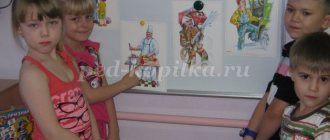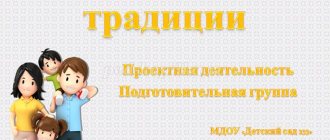Senior group project “Autumn has come to visit us”
GCD:Drawing
(subject)
1. Topic:
"Cosmea".
Program content.
To develop children's aesthetic perception and sense of color. Learn to convey the characteristic features of cosmos flowers: the shape of the petals, leaves, their color. Continue to introduce children to watercolor paints and teach them how to work with them.
2.Theme:
"Riddles from the garden"
Program content.
Learn to convey shape and characteristic features by their description in riddles; create expressive and fantasy images; mix paints yourself to obtain the desired shade; clarify the idea of well-known natural objects.
3.Theme:
"Autumn Leaves" (autumn colors)
Program content.
Teach children to draw from life, conveying the shape and color of autumn leaves. Improve visual technique (mix watercolor paints to obtain complex shades and convey autumn color). Introduce a new way of obtaining an image - applying paint to leaves, trying to convey the color and “printing” them on paper. Encourage children to embody their ideas, experiences, and feelings in artistic form; evoke a desire to convey the characteristic features of objects and natural phenomena; support creativity.
4.Subject:
"Trees in our park"
Program content.
Learn to draw a deciduous tree, conveying the characteristic features of the structure of the trunk and crown (birch, oak, willow, aspen) and convey colors; develop technical skills in drawing with pencils, paints and other materials. Improve visual skills and develop the ability to create expressive images using various media.
Drawing
(story)
1. Topic:
“The red summer has passed (colors of summer).”
Program content.
teach children to create a harmonious color composition (creating non-objective (abstract) compositions; drawing up a summer color palette), conveying impressions of summer. Introduce a new way of creating an abstract composition - free, continuous movement of a pencil or felt-tip pen on paper (exercise “line on a walk”). Improve your technique of painting with watercolors (wash and wet your brush often, move it freely in all directions).
2.Theme:
"Apple tree with golden apples in a magical garden."
Program content.
Teach children to create a fairy-tale image, draw spreading trees, conveying the branching of the crown of fruit trees; depict a lot of “golden” apples. Strengthen the ability to paint with paints (rinse the brush well before picking up paint of a different color, blot the brush on a napkin, do not paint on wet paint); Develop aesthetic perception and sense of composition. Learn to arrange images beautifully on a sheet of paper.
3.Theme:
"It's raining".
Program content.
Teach children to figuratively reflect impressions of life around them in drawings. Strengthen the ability to build a composition of a drawing. Teach children to use acquired techniques for various transmission of phenomena. Practice drawing with simple graphite and colored pencils (colored wax crayons).
4.Theme:
"Autumn forest".
Program content.
teach children to reflect autumn impressions in drawings, to draw a variety of trees (large, small, tall, low, slender, straight and crooked). Learn to depict trees, grass, leaves in different ways. Strengthen the techniques of working with a brush and paints. Develop activity and creativity. Continue to develop the ability to enjoy beautiful drawings.
Application
1.Topic:
“Cucumbers and tomatoes are on a plate”
Program content.
continue to practice children’s ability to cut round and oval-shaped objects from squares and rectangles, cutting off the corners using a rounding method. Develop coordination of movement of both hands. Strengthen the ability to carefully paste an image.
2.Theme:
"Dish with fruits and
berries" (teamwork)
Program content.
Continue to practice techniques for cutting out round and oval-shaped objects. Teaches how to make small indentations with scissors by eye to convey the characteristic features of objects. Reinforce techniques for careful gluing. Develop teamwork skills. Develop a sense of composition.
Modeling
1.Topic:
"Mushrooms"
Program content.
Develop perception, the ability to notice differences from the main reference form. Strengthen the ability to sculpt objects or parts of them into round, oval, disc-shaped shapes, using the movement of the entire hand and fingers. Learn to convey some characteristic features: indentation, curved edges of mushroom caps, thickening legs.
2.Theme:
"The leaves dance and turn into trees."
Program content.
Encourage children to want to make sculpted paintings. Introduce the technique of relief modeling. Offer a choice of methods for decorating a stucco image: relief moldings, cutting or scratching with stacks. Develop a sense of form and composition.
Creative project at the preschool educational institution “Autumn colors, motley round dance”
- December 21, 2016
Fast distance online competitions
Competition “Methodological collection of a kindergarten teacher”
Today, the project method, considered as a learning system, has gained wide popularity in preschool educational institutions. The Federal State Educational Standard for Preschool Education states that the content of the educational program of a preschool educational institution “should ensure the development of the personality, motivation and abilities of children in various types of activities” in five areas of development and education of children: social and communicative development, cognitive development, speech development, artistic and aesthetic development, physical development. (Order No. 1155 dated October 17, 2013)
Working in a project, there is an opportunity to develop a child in all these areas. By implementing a group project, we develop in children the ability to work in a team, feel like a member of a team, make decisions, and analyze the results of activities.
Middle preschool age is the peak of curiosity, a vibrant period of discovery. The potential of preschool children grows, the desire to learn increases, which coincides with intellectual capabilities. It is very important during this period not to let the child get tired of learning. We must not forget about the change of activities within the framework of classes, about the child’s need for movement in the process of OD.
Project activities are interconnected in such a way that information obtained from one experience serves to develop and enrich with new experience, which is based on current children's interests. All this prepares children favorably for school.
Project passport
Problem . In the autumn period, we traditionally introduce children and expand their knowledge about autumn, its signs and signs, about the work of adults in the autumn period, about changes in nature, etc. And we always face the question: how can we choose more interesting events on the topic? So that autumn is not a “sad time” in the eyes of children; so that children can see all the beauty of this time of year. We developed a project, which received the following name: “Autumn colors, colorful round dance.”
Hypothesis: Each season brings beauty and charm and gives children new knowledge and ideas.
Participants : teachers, children of the middle group of the kindergarten "Luchiki", parents of pupils.
Type of project : creative - educational.
Implemented educational areas: Cognitive development; Artistic and aesthetic development; Speech development; Social and communicative development.
Project goals:
- development of cognitive abilities and interest in further educational activities of preschoolers;
- developing positive emotions in children from communicating with the world of knowledge.
- unity of participants in educational relations: children, parents, teachers.
Planned results - targets:
- The preschooler shows interest in the natural world around him and participates with interest in seasonal observations and research and experimental activities.
- He speaks actively, asks questions to adults and peers, and uses speech to express his thoughts.
- Shows independence in various types of activities, including productive ones, and responds emotionally to visual activities.
- Familiar with works of children's literature.
- Has basic understanding of the areas of living and inanimate nature, and shows curiosity.
- Knows how to play alongside peers, takes into account the interests and feelings of others, adequately expresses his feelings;
can follow social norms of behavior.









